Latest News
December 10, 2008
By Margaret S. Gurney
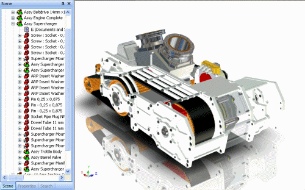 See an animated Zoom to Selection example. |
By combining history-based parametrics and direct geometry manipulation into a single modeling environment, IRONCAD V11 brings fun back into 3D design process, according to IronCAD LLC (Atlanta, GA). IRONCAD’s drag and drop 3D environment provides an alternative to traditional history-based parametric systems, says the company, and gives designers and engineers greater design freedom and flexibility, enabling them to get products to market faster and with better quality. Judging by the company’s online presentation of all the new attributes, these claims seem substantiated.
“We have worked closely with our customers to find ways to simplify and streamline their design processes while strengthening our product to meet the needs of our market, and this release is a direct result of these efforts.” |
“IRONCAD Version 11 is a significant step forward for the product, not only allowing users to operate on newer 64-bit and Vista platforms,” said Dr. Tao-Yang Han, president of IronCAD, “but also delivering numerous features that have been requested by our user base and market to make our product more productive. We have worked closely with our customers to find ways to simplify and streamline their design processes while strengthening our product to meet the needs of our market, and this release is a direct result of these efforts.”
Along with the customer-driven requests, IRONCAD Version 11 offers improvements to the creative design approach as well, which, the company claims, offers a level of design freedom that is unmatched in the industry today.
What’s New in Assembly Management
First in the list for new features in IRONCAD Version 11 under Assembly Management Improvements include Windows 64-bit operating system support for large assembly data. This is in response to customers using IronCAD and continually expanding their needs for large assembly data.
New loading capabilities have been added to improve the memory management and load/save times on large assembly data in this version. During the opening of files in the Advanced OpenGL/Direct3D rendering mode, only the structure and feature information will be loaded along with the lightweight graphical information.
Many changes to the internal environment of IRONCAD are said to improve the interaction of data when large assembly data is loaded, including selection, edit of geometry, drag and drop of new geometry, and more.
Improvements have been made in the 2D technical drawing environment to enhance performance in the view creation process.
The Zoom to Selection option now is available in the Scene Browser and the graphical display area to quickly zoom to the component being worked on. You can apply this command to assemblies, parts, and even features. Combining this option with other IRONCAD utilities, such as the Hide Command, can improve time navigating the display to find critical components.
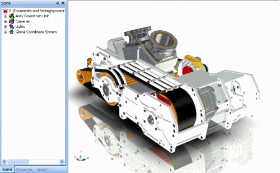 See an animated Find in Scene Browser example. |
Another common interaction command for large assemblies, the Find in Scene Browser, helps reduce design time spent navigating the structure to find the selected components. This new command automatically directs you to the selected object in the scene browser, which will expand to the correct level to allow you direct access to the item.
Assemblies can now carry calculated and specified mass values can be transferred to the Bill of Materials on the drawing. The calculated mass is a calculation of the total mass of all parts included in the assembly. Specified mass gives you the ability to assign a set mass for the assembly. This setting is useful for imported data that you may want to use in your calculations. The mass settings are found in the assembly properties and the specified mass can also be set in the property browser of the assembly.
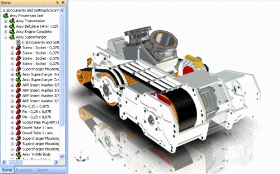 See an animated Search Browser example. |
New User Interaction Improvements
A new advance search capability has been added to IRONCAD Version 11 to help navigate product structures in the design. This new capability not only searches for assembly, part, and IntelliShape names, but it can search part properties, suppressed items, hidden items, and custom applied properties. The search results are fast and clearly presented with a hierarchical display. Additionally, you can select search results and perform actions on the selection as if you were working in the normal Scene Browser.
Other user-interaction improvements include Double-Click Edit Dimension support on common dimensions applied in the design environment, which can improve overall design time by reducing the amount of mouse-clicks needed to perform a task. Double-click editing can be performed on 3D dimension, Sizebox dimensions (including assembly, part, and IntelliShape levels), TriBall position dimensions, and 2D sketch constraint dimensions.
Within complex assembly structures, many mouse-clicks are usually necessary to drill down to the selected design state that you will be editing. Not any more. IRONCAD Version 11 has introduced direct drill-down hot-keys to access the part and assembly levels.
The Prevent Editing Setting on Parts/Assemblies function prevents users from accessing data below the level where you have applied the setting. Visual indicators in both the Scene Browser and in the graphical selection area have been added to indicate if the setting has been applied.
Users can also benefit from other enhancements including Assembly/Part Cursor Mouse-over Icons, Multiple Select Quick Access Property Browser capability, and re-sizable file open/save dialogs.
Detailed Sketch Improvement
The 2D sketch offset command has been enhanced to support an offset constraint and the ability to create a bidirectional offset. The offset constraint lets you create an association between the originating curve and offset curve, allowing you to modify the offset curves where both will update to maintain the offset distance.
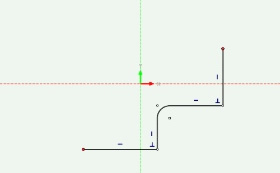 See an animated example of 2D Sketch Offset Improvements. | 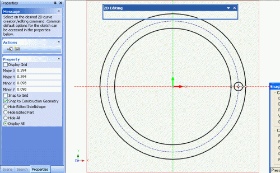 See an animated example of a 2D Sketch Linear and Circular Pattern. |
Improvements to the BSpline tool give you more control and accuracy, allowing you to create more complex geometry. These improvements include tangency magnitude and angle, dimension constraints to spline endpoint and control points, dimension constraints to tangency magnitude and angle, mirror constraint support for splines, projection constraint support for splines, display curvature improvements on splines, and offset tolerance accuracy control.
Other improvements under detailed sketch options include reference point capability in the 2D Sketch and 2D Sketch Quick Access property browser command updates.
New linear and circular pattern tools have been introduced into the 2D Sketch environment that allow you to create patterned geometry in the Sketch. This initial implementation lets you select the desired patterned curves and definitions to create a non-associative pattern. Future enhancements will be added to support pattern constraints, the company says.
Plus, about ten improvements have been made to constraint dimensions, including midpoint, arc length dimension, arc angle dimension, and solving mode options.
Detailed Part Design Improvements
Enhancing the current IRONCAD Boolean capabilities, IRONCAD Version 11 now supports the ability to retain features of both Boolean parts for editing after the Boolean operation. Users will be able to access the features in the Scene Browser to make edits to the Boolean part.
Other part design improvements include Loft improvements for centerline guide curve, true/real thread creation on cylindrical surfaces, variable pitch helix spring support, 2-plane projection to single curve capability, wrap 3D curve to cylindrical surface, project 3D curves to multiple surfaces, and such import/export improvements as imported Parts Default to Triangulated Mesh, Combine All Shapes to Single Shape, Combine Only Surfaces Shapes, and Maximum Sewing Tolerance Settings.
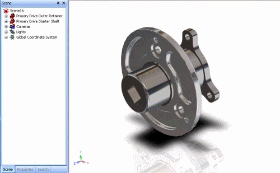 See an animated example of the Part-to-Part Boolean Feature. | 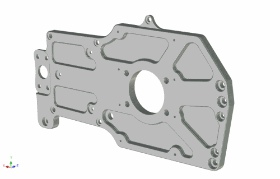 See an animated example of a TriBall Multiple Copy/Link. |
3D Positioning Improvements
Improvements to reduce design times have been added to the TriBall positioning tool. One of these improvements includes the new multiple point creation capability for copy and link operations. In addition to the copy/link at multiple locations capability, the TriBall has also been enhanced to support multiple reference locations.
Other 3D positioning improvements include position TriBall center command with multiple shapes selected, TriBall short-cut assignments, and TriBall move shape with visual highlights. SmartAssembly sees new connection options and improvements to SmartAssembly stretch operations.
3D Visibility Improvements
Improvements to the Advanced OpenGL/Direct3D rendering mode are said to enhance the visualization of models during detail design processes. These improvements can also be used to take quick screen captures to communicate your design to members outside the design team without the need for full realistic rendering. Improvements include Shadow plane support, reflection plane support in 3D, real-time shadow mapping support (Direct3D only), line antialiasing, and full-screen antialiasing.
Other improvements under 3D visibility include a Direct3D/OpenGL user setting option and hide part/assembly identification in Scene Browser as well Show Selected Support.
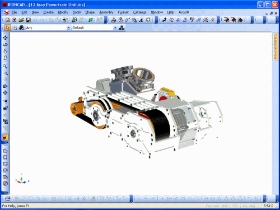 See an animated example of a Real-time Shadow Plane. | 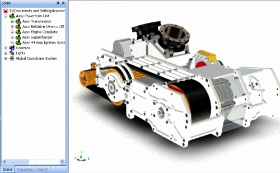 See an animated Scene Browser Hide Icons and Show Selected example. |
2D Technical Drawing Improvements
The Part/Assembly Selection for View Creation has been updated to fully support the Quick View creation type. This enhancement allows users to take advantage of the fast view creation capabilities and single scene environment design. The combination saves time in creating many external linked files and time generating more precise views during the design and layout stages.
It is also possible to use a new style option that has been added to Text with Leaders for automatic justification of the text during creation and edit. You can use edit section line capabilities to redefine section lines. Enhancements include multiple broken-out section view on single views, a shaded view option flag during creation of the view, a fast Advanced OpenGL/Direct3D view creation preview capability, and double-click editing of drawing sheet tab name. You can now export drawings to DWG/DXF using a page scale option.
System News & Updates
IRONCAD Version 11 also provides Windows Vista support, and it offers Advanced OpenGL/Direct 3D upgrade improvements, and Unicode support. Various subsystem support including ACIS, CATIA V5, D-Cubed, Parasolid, PTC Granite, Spatial 3D, TechSoft, and Unigraphics has been upgraded as well.
Shipments of IRONCAD Version 11 to existing customers will begin at the beginning of January 2009. An evaluation copy of the latest product version is available for download today from www.ironcad.com. All new customers buying IRONCAD will automatically receive Version 11.
Get an in-depth and highly illustrated overview of the new features in IronCAD Version 11.
Read why DE‘s editors chose this as a Pick of the Week.
For links to case studies in IronCAD applications in aerospace, automotive, consumer products, interior design, mechanical/mold/marine design, and medical design, go to the company’s IronCAD in Action web page.
For a full detailed list of new features, visit IronCAD.
Margaret S. Gurney is the editor for new products at Desktop Engineering magazine.
Subscribe to our FREE magazine, FREE email newsletters or both!
Latest News
About the Author
DE’s editors contribute news and new product announcements to Digital Engineering.
Press releases may be sent to them via [email protected].






